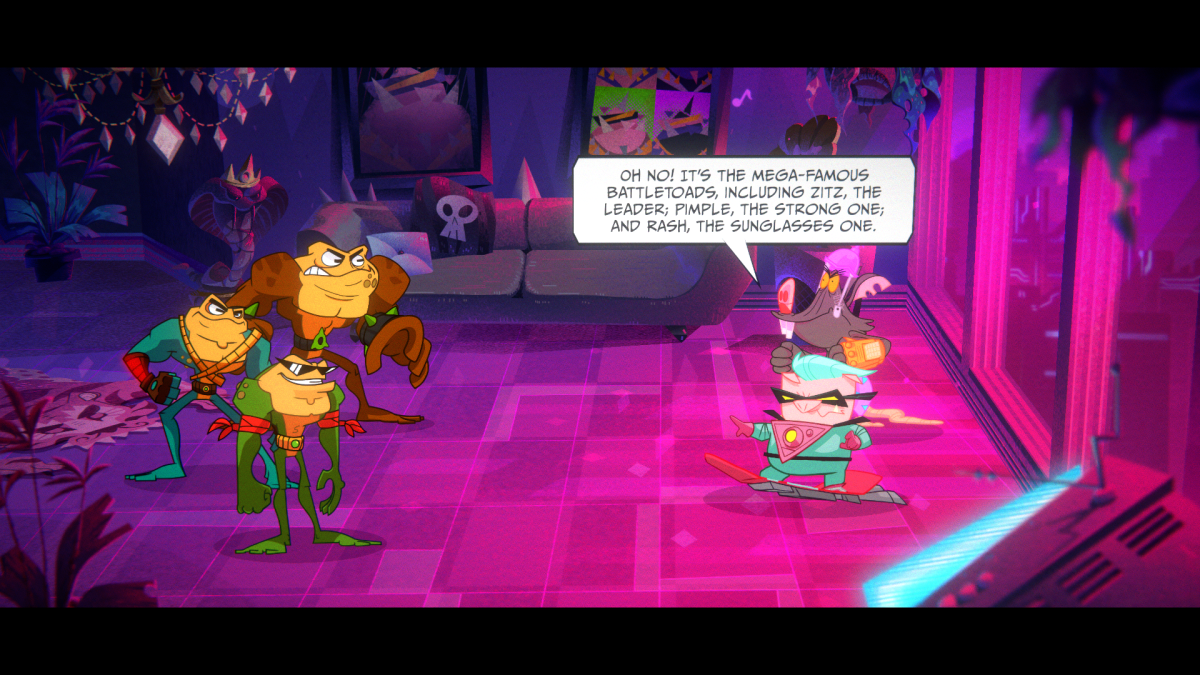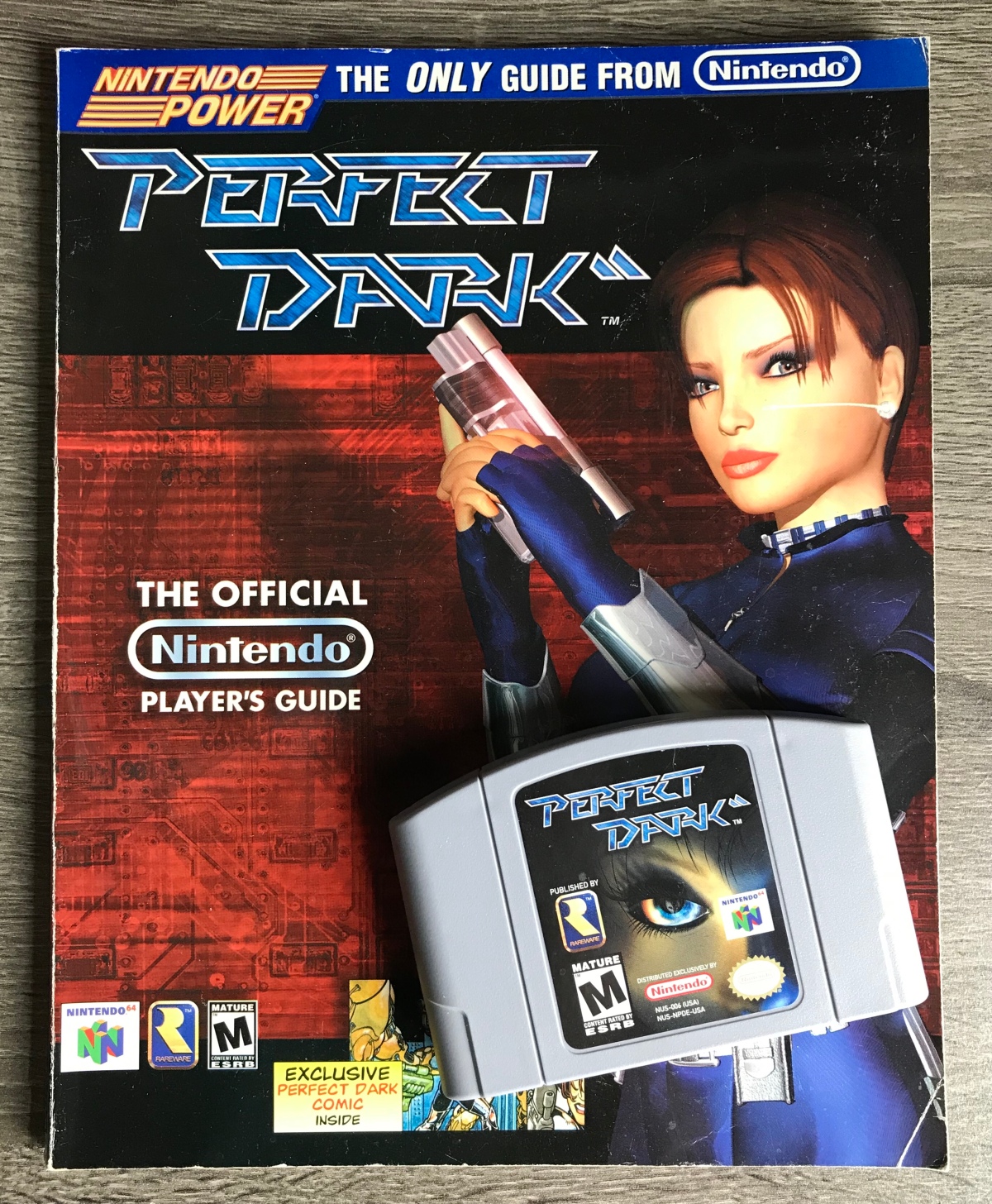Battletoads is a weird game. The newest Microsoft exclusive is developed by Dlala Studios as well as Rare, who created the previous games beginning with the 1991 NES title. It’s difficult to accurately describe Battletoads as a game other than – too many things and not quite enough of ONE SPECIFIC thing. There’s an absurd variety of gameplay styles and mechanics being thrown at you at any given moment, including – beat ’em up, turbo bike segments, puzzle-platformer, shoot ’em up, countless button-pressing mini-games and even a variation of rock-paper-scissors called Toad-Sham-Bo. It’s the first game in the franchise since the Battletoads Arcade game in 1994 and for better or worse, feels very much like a heaping handfull of elements of the 90’s – beat ’em ups, gross-out humor, Crystal Pepsi and Zubaz were thrown into a blender and playing through the resulting concoction.

Battletoads begins with the trio of amphibian brothers(they are, right?) – Rash, Pimple and Zitz battling their way through the streets as you fight rats and the familiar villainous swine – Porkshank. Each of the game’s four acts are divided into chapters with the first acting as a very basic tutorial for the combat elements of the game – normal and heavy attacks, tongue grab and spitting bubblegum. At the end of the first level the toads waltz their way to a victory ending with a stroll down the red carpet for a crowd of cheering fans. Not quite. The Battletoads are then discovered by a construction crew as it’s revealed their heroic exploits have all been imagined as they have been stuck in an underground bunker for the past 26 years and have since faded from relevance.
The very next chapter shows the toads as they have taken day jobs sending corporate emails, working as a masseuse, and signing autographs at conventions. This is the first of many chapters devoted to a series of mini-games as you press a series of buttons on the controller as Zitz sends out emails, rotate the joysticks in corresponding directions as Pimple massages a client, and alternate between right and left triggers as Rash goes through a pile of photos at a signing table.
In Chapter 3 we see Rash struggle with adjusting to life outside of pummeling rats and pigs and he concocts a plan to seek out their arch-nemesis, the Dark Queen, who is holed up at an abandoned theme park…or so Rash has assumed. The Battletoads set off towards the theme park on rented turbo bikes as the entire level is spent avoiding a number of columns and roadblocks in an obvious callback to the infamous turbo bike levels on the NES.

Upon arriving at the abandoned theme park, the next two chapters are primarily comprised of familiar beat ’em up mechanics, with a few electrical current puzzles to solve along the way. The combat mechanics in Battletoads are very fluid and you can pretty easily string together a decent combo of hits on the (annoyingly)durable enemies. This is one of my initial complaints of the game – you are frequently ambushed by an entire room full of enemies, which isn’t anything new to the genre, but, between dodging a number of projectile and area attacks it becomes VERY difficult to keep track of what’s happening on-screen. I wound up losing countless lives simply because I couldn’t follow the barrage of colorful enemies and attacks in front of me.
I find the strangest aspect of Battletoads is that the beat ’em up gameplay is abandoned almost completely after the first two acts, with the third act(the longest of the four) alternates between acting as a top-down, twin stick shooter and puzzle-platformer levels. There’s also a set of mini-games in the final chapter of Act Three that I found insanely frustrating as you are given a screen made up of seven different puzzles to solve within the given time limit. I absolutely hated this sequence. There’s SO MUCH on screen that I found it incredibly difficult for my eyes to even detect which puzzle-tile I was supposed to be focusing on. I’m totally fine with unexpected twists and turns within a given game’s storyline and characters, or even variations in gameplay mechanics are rarely unwelcome in games that I play, but this was pushed to an extreme in Battletoads. While making my way through the game I actually said aloud, “what the hell is this game gonna expect me to do next?”.

One of the standout elements of Battletoads is its wonderful hand-drawn characters and backgrounds; the animations are very well done and have a very nice Nickelodeon-esque look to them(the art style is strikingly similar to The Fairly Oddparents). The story itself fits the tone and humor of the early 90’s Nicktoons like Ren & Stimpy or Rocko’s Modern Life, I found myself laughing out loud a few different times(the mature, refined indiviual I am) by the combination of bizarre/gross-out humor and number of referential jokes making light of the series’ twenty plus-years of irrelevance. Another game I referenced while playing through Battletoads was Earthworm Jim as they share a common ability to make me laugh simply with sight gags and sound effects(I told you, classy stuff).
Another highlight of the game is the soundtrack and sound effects. The level music perfectly fits the rock/metal genre one would expect from a brawler-type game, I found much of it stuck in my head throughout the day after playing. The sound effects in the game are very crisp and crunchy, lending themselves nicely to the genre and overall humor of the game, similar to Rocko’s Modern Life or Earthworm Jim.
There’s so much going on in Battletoads that even those devoid an attention span such as myself found it a bit hard to follow. The game has some quality moments and is a pretty damn good beat ’em up when it wants to be, but often feels as if the game itself couldn’t decide which direction to go. The controls and animations are enjoyable enough despite the overload of on-screen action at times. It’s interesting that both Battletoads and Streets of Rage received sequels after the last entries of each respective series happening well over twenty years ago. Streets of Rage 4, I feel is the overall better game as it’s a little more of a condensed experience that sticks to what it does best while Battletoads is a lighter, slightly more forgiving playthrough with a little bit of everything…and then some. Do I recommend Battletoads? For anyone who grew up during the 90’s and/or has played the previous games, it’s defninitely worth giving a try, especially for those with a Game Pass subscription, where you can currently play both Battletoads and Streets of Rage 4. #NotAGamePassAd
If anyone else has played the game, I’d love to hear your thoughts. Here’s a few more screenshots to showcase the ridiculous amount of stuff thrown at you…thanks for reading!








